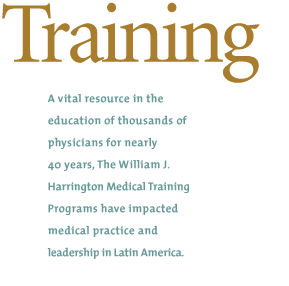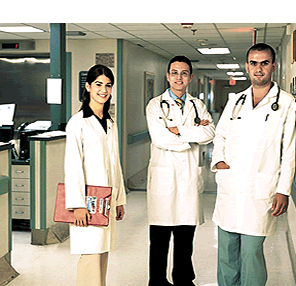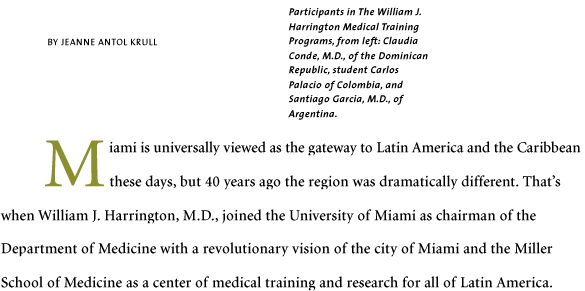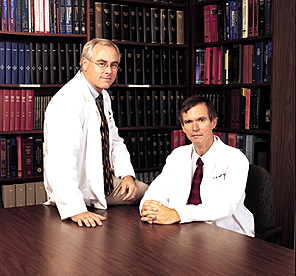 |
||
 |
 |
|
 |
||
He immediately began laying the groundwork for what today are The William J. Harrington Medical Training Programs for Latin America. The first participants were accepted in 1967; since then 2,336 people have taken part in some component of the program.
 |
||
 |
||
“My father’s idea was really very simple: make the medical school a sort of Pan American institute of medical academics for Latin America,” says William J. Harrington Jr., M.D., professor of medicine and co-director of the Latin American program. “His idea was for physicians to train here and return to their own country to influence their communities through medical education and leadership.”
The program has three main components: rotation opportunities for medical students to observe in several different clinical departments; continuing education for physicians already practicing in their home country; and the program’s crown jewel, the internal medicine residency program. Each year, up to 12 positions in the Jackson Memorial Hospital Residency Training in Internal Medicine go to Latin American physicians. The criteria for admission are stringent.
“The medical graduates that we accept are the cream of the crop in their country, and they routinely turn out to be among the best residents in the program,” says J. Donald Temple, M.D., program director. “The candidates must speak fluent English, plus undergo a personal interview and have a recommendation in writing from one of our adjunct faculty in their home country. In addition, we try to select people who we believe will return home to practice medicine.”
Most do end up going back, but since they are urged to pursue a fellowship, their stay can last up to seven years. Many marry during that time and start a family, making it tougher to leave. In other cases, the political situation may have changed in their home country, making it difficult to return. Residents in the program are encouraged to specialize because, unlike the U.S. where there are too many specialists, there aren’t enough in Latin America, due to lack of training and technology. “The success of the program depends on these physicians returning home where they can have a tremendous impact in their communities, otherwise our adjunct faculty in Latin America will become reluctant to recommend their best and brightest to us for training,” says Temple.
Santiago Garcia, M.D., is looking forward to returning home one day. He received a medical degree from the University of Buenos Aires in 1999, and was in his second year of residency in cardiology when the economy in Argentina collapsed and his program was closed. He applied to the Harrington program and started in 2002. “Miami is a friendly city for people from Latin America, from the language to the culture,” Garcia says. “It is a comfortable environment, but it’s still tough being away from family.
“My experience here is going to give me a completely different perspective when I return home. I am hopeful I will be able to transmit that knowledge to my colleagues, especially the team approach we use in medicine. In Latin America medicine is more centered around the doctor; but here we work in a team that includes an attending physician, residents, medical students, and a nurse practitioner, all working together as a cohesive unit.”
Next year two of the four chief resident positions will be held by Harrington program participants. Garcia will be the chief medical resident in internal medicine at the Veterans Administration Medical Center in Miami. He plans to apply for a fellowship in cardiology. Garcia’s wife, Mariana Canoniero, M.D., is a second-year resident in the program.
An added advantage to the program is that the Miller School of Medicine now has more than 60 adjunct faculty members spread across Latin America, the majority graduates of the Harrington program. “These faculty members have a tremendous loyalty to UM, and we depend on them to be our eyes and ears and to send us the very best students and residents,” says Harrington.
One physician who has referred students to the program is Daniel Tabak, M.D., a Harrington participant in the early 1980s shortly after his graduation from the Federal University of Rio de Janeiro School of Medicine. “Today I have no doubt that when I finished my training at UM/Jackson, I was the best doctor I had ever been in my life,” says Tabak.
After returning to Brazil, he headed up the bone marrow transplantation unit at the National Cancer Institute in Rio de Janeiro for almost 20 years while continuing his private practice. “To this day when I conduct rounds with the residents and fellows, I go through the same routine I followed at Jackson. And I always tell them the story of Dr. William Harrington and how he changed my life so dramatically by accepting me in the Latin American Training Program.”